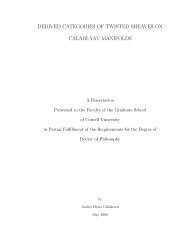A Course on Large Deviations with an Introduction to Gibbs Measures.
A Course on Large Deviations with an Introduction to Gibbs Measures.
A Course on Large Deviations with an Introduction to Gibbs Measures.
You also want an ePaper? Increase the reach of your titles
YUMPU automatically turns print PDFs into web optimized ePapers that Google loves.
4.2. Varadh<strong>an</strong>’s theorem <strong>an</strong>d Bryc’s theorem 35<br />
is the Cramér rate for the law of Sn/n; see (1.1) <strong>an</strong>d use the c<strong>on</strong>tracti<strong>on</strong><br />
principle. The above supremum is attained at x = 2<br />
3 log 2 instead of E[X1] =<br />
log √ 2. Thus, the paths that c<strong>on</strong>tribute the most are the <strong>on</strong>es for which<br />
Sn/n ∼ 2<br />
3 log 2, i.e. Wn ∼ (22/3 ) n . They do occur <strong>with</strong> <strong>an</strong> exp<strong>on</strong>entially<br />
small probability, but when they do occur, they have <strong>an</strong> exp<strong>on</strong>entially large<br />
c<strong>on</strong>tributi<strong>on</strong>. The two bal<strong>an</strong>ce out <strong>to</strong> produce the me<strong>an</strong> value (3/2) n . LDP<br />
<strong>an</strong>d the rate functi<strong>on</strong> has a unique zero at x = 2<br />
3 log 2.<br />
The above exercises <strong>an</strong>d example point <strong>to</strong> a relati<strong>on</strong>ship between large<br />
deviati<strong>on</strong>s <strong>an</strong>d statistical mech<strong>an</strong>ics where <strong>on</strong>e encounters integrals of the<br />
form e nf dµn. The distributi<strong>on</strong>s νn in Exercise 4.9 are examples of <strong>Gibbs</strong><br />
measures. We will see more of this in the sec<strong>on</strong>d part of the course. The<br />
next Secti<strong>on</strong> 4.3 provides <strong>an</strong> appetizer in the c<strong>on</strong>text of a me<strong>an</strong>-field model.<br />
Varadh<strong>an</strong>’s theorem gives asymp<strong>to</strong>tics of integrals as a c<strong>on</strong>sequence of<br />
<strong>an</strong> LDP. Perhaps not surprisingly, knowing the asymp<strong>to</strong>tics of sufficiently<br />
m<strong>an</strong>y integrals is equivalent <strong>to</strong> <strong>an</strong> LDP. Let Cb(X ) denote the set of bounded<br />
<strong>an</strong>d c<strong>on</strong>tinuous functi<strong>on</strong>s <strong>on</strong> X .<br />
Bryc’s theorem. Let {µn} be a sequence of probability measures <strong>on</strong> a metric<br />
space X . Assume {µn} is exp<strong>on</strong>entially tight <strong>with</strong> normalizati<strong>on</strong> rn.<br />
Suppose the limit<br />
1<br />
Γ(f) = lim<br />
n→∞ rn log<br />
<br />
e rnf dµn<br />
exists for all bounded c<strong>on</strong>tinuous functi<strong>on</strong>s f. Then, LDP(µn, rn, I) holds<br />
<strong>with</strong> the tight rate functi<strong>on</strong><br />
(4.2)<br />
I(x) = sup<br />
f∈Cb(X )<br />
{f(x) − Γ(f)}.<br />
The above theorem reminds us again of weak c<strong>on</strong>vergence of probability<br />
measures.<br />
Of course, given the LDP, Varadh<strong>an</strong>’s theorem implies that Γ(f) =<br />
sup(f − I). Note, however, that the relati<strong>on</strong> between Γ <strong>an</strong>d I is not the<br />
c<strong>on</strong>vex duality we will see in Chapter 5, where the functi<strong>on</strong>s f are c<strong>on</strong>tinuous<br />
linear functi<strong>on</strong>s. Even though until this point we have <strong>on</strong>ly seen c<strong>on</strong>vex rate<br />
functi<strong>on</strong>s, the rate functi<strong>on</strong> in (4.2) need not be c<strong>on</strong>vex; recall Definiti<strong>on</strong><br />
2.14. In fact, the next secti<strong>on</strong> has <strong>an</strong> LDP <strong>with</strong> a n<strong>on</strong>c<strong>on</strong>vex rate functi<strong>on</strong>.<br />
Also, Exercise 5.27 shows how simple it is <strong>to</strong> come up <strong>with</strong> such a situati<strong>on</strong>.<br />
Proving that the limit Γ(f) exists for all bounded c<strong>on</strong>tinuous functi<strong>on</strong>s<br />
may be <strong>to</strong>o hard <strong>to</strong> achieve. However, for the LDP <strong>to</strong> hold <strong>on</strong>e really<br />
needs the limit <strong>to</strong> exist for a rich enough class of functi<strong>on</strong>s; see for example<br />
Theorem 4.4.10 of [8].<br />
If X a metric vec<strong>to</strong>r space, then a rich enough class of functi<strong>on</strong>s that<br />
would ensure the LDP via Bryc’s theorem is the class of c<strong>on</strong>cave Lipschitz
















